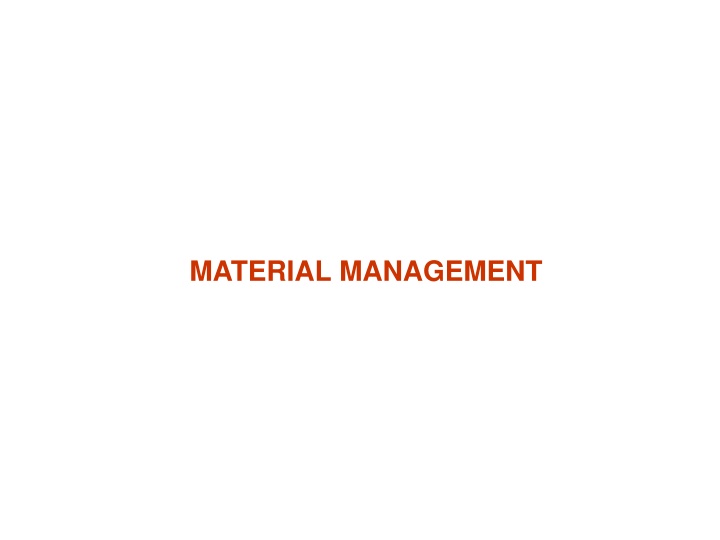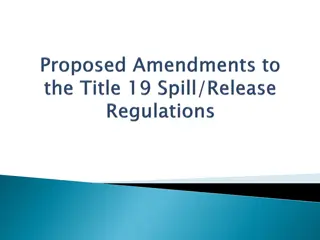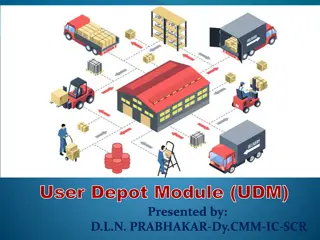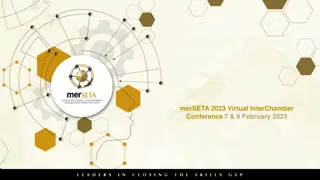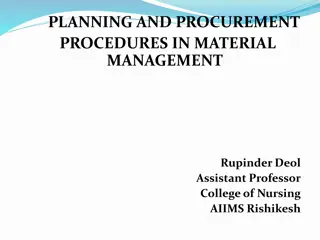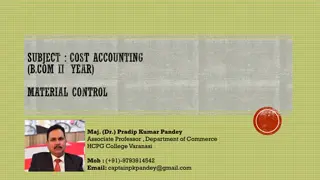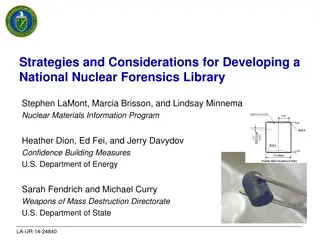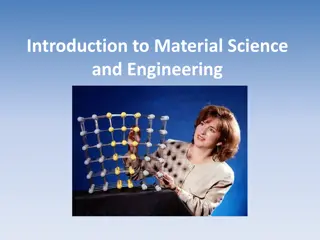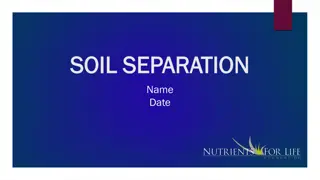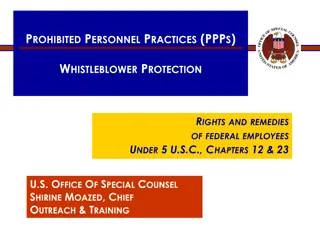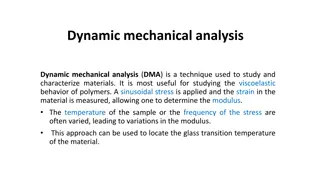Overview of Material Management Practices
Material management involves planning, organizing, and controlling the flow of materials from purchase to distribution. It encompasses techniques like purchase orders, inventory level checks, and economic ordering quantities to ensure the right quality and quantity of supplies at the right time and cost-effectively. The primary objectives include achieving the right price, high turnover, and continuity of supply, among others. The aim is to satisfy demand, stabilize consumption fluctuations, and provide optimal client service.
Download Presentation

Please find below an Image/Link to download the presentation.
The content on the website is provided AS IS for your information and personal use only. It may not be sold, licensed, or shared on other websites without obtaining consent from the author.If you encounter any issues during the download, it is possible that the publisher has removed the file from their server.
You are allowed to download the files provided on this website for personal or commercial use, subject to the condition that they are used lawfully. All files are the property of their respective owners.
The content on the website is provided AS IS for your information and personal use only. It may not be sold, licensed, or shared on other websites without obtaining consent from the author.
E N D
Presentation Transcript
Definition It is concerned with planning, organizing and controlling the flow of materials from their initial purchase through internal operations to the service point through distribution. OR Material management is a scientific technique, concerned with Planning, Organizing &Control of flow of materials, from their initial purchase to destination.
Purchase Order: A document authorizing the purchase of a product or service from a vendor Traveling Requisition: A catalog of products used to order supplies stocked by material management Standing Orders: A purchase order issued for a product or service to be delivered according to a preset schedule
Inventory Level Checks Perpetual System: A system that keeps account of the inventory each time a product is used or removed from inventory Periodic System: A system whereby inventory levels are checked according to an established timetable Random Checks: A method used to verify inventory levels
Economic Ordering Quantity (EOQ): A formula used to determine the quantity of supplies to order at one time Economic Ordering Point (EOP): The point at which inventory should be re-ordered Optimal Reorder Time (ROT): The best time to place an order to take advantage of EOQ and EOP
AIM OF MATERIAL MANAGEMENT To get 1. The Right quality 2. Right quantity of supplies 3. At the Right time 4. At the Right place 5. For the Right cost
PURPOSE OF MATERIAL MANAGEMENT To gain economy in purchasing To satisfy the demand during period of replenishment To carry reserve stock to avoid stock out To stabilize fluctuations in consumption To provide reasonable level of client services
Objective of material management Primary Right price High turnover Low procurement & storage cost Continuity of supply Consistency in quality Good supplier relations Development of personnel Good information system Secondary Forecasting Inter-departmental harmony Product improvement Standardization Make or buy decision New materials & products Favorable reciprocal relationships
Economy in material management Containing the costs Instilling efficiency in all activities
Four basic needs of Material management 1. To have adequate materials on hand when needed 2. To pay the lowest possible prices, consistent with quality and value requirement for purchases materials 3. To minimize the inventory investment 4. To operate efficiently
Basic principles of material management 1. Effective management & supervision It depends on managerial functions of Planning Organizing Staffing Directing Controlling Reporting Budgeting 2. Sound purchasing methods 3.Skillful & hard poised negotiations 4.Effective purchase system 5.Should be simple 6.Must not increase other costs 7.Simple inventory control programme
Elements of material management 1. Demand estimation 2. Identify the needed items 3. Calculate from the trends in Consumption during last 2 years. 4. Review with resource constraints
Functional areas of material management 1. Purchasing 2. Central service supply 3. Central stores 4. The print shops 5. The pharmacy 6. Dietary & Linen services
Procurement cycle Review selection Determine needed quantities Reconcile needs & funds Choose procurement method Select suppliers Specify contract terms Monitor order status Receipt & inspection
Objectives of procurement system Acquire needed supplies as inexpensively as possible Obtain high quality supplies Assure prompt & dependable delivery Distribute the procurement workload to avoid period of idleness & overwork Optimize inventory management through scientific procurement procedures
Points to remember while purchasing Proper specification Comparison of offers based on basic price, freight & insurance, taxes and levies Quantity & payment discounts Payment terms Delivery period, guarantee Vendor reputation (reliability, technical capabilities, Convenience, Availability, after- sales service, sales assistance) Short listing for better negotiation terms Seek order acknowledgement
Storage Store must be of adequate space Materials must be stored in an appropriate place in a correct way Group wise & alphabetical arrangement helps in identification & retrieval First-in, first-out principle to be followed Monitor expiry date Issue & use Can be centralized or decentralized
Inventory control It means stocking adequate number and kind of stores, so that the materials are available whenever required and wherever required. Scientific inventory control results in optimal balance
Functions of inventory control To provide maximum supply service, consistent with maximum efficiency & optimum investment. To provide cushion between forecasted & actual demand for a material
Economic order of quantity EOQ = Average Monthly Consumption X Lead Time [in months] + Buffer Stock Stock on hand ECONOMIC ORDER OF QUANTITY(EOQ) CARRYING COST PURCHASING COST
Re-order level: stock level at which fresh order is placed. Average consumption per day x lead time + buffer stock Lead time: Duration time between placing an order & receipt of material Ideal 2 to 6 weeks.
For maximum financial benefit and storage space utilization, order 469 packs of plates each time the inventory drops to 211 (about every 16 days)
PROCURMENT OF EQUIPMENT Points to be noted before purchase of an equipment: Latest technology Availability of maintenance & repair facility, with minimum down time Post warranty repair at reasonable cost Upgradeability Reputed manufacturer Availability of consumables Low operating costs Installation Proper installation as per guidelines
HISTORY SHEET OF EQUIPMENT: History sheet Name of equipment Code number Date of purchase Name of supplier Name of manufacturer Date of installation Place of installation Date of commissioning Environmental control Spare parts inventory Techn. Manual / circuit diagrams / literatures After sales arrangement Guarantee period Warranty period Life of equipment Down time / up time Cost of maintenance Unserviceable date Date of condemnation Date of replacement
EQUIPMENT MAINTENANCE & CONDEMNATION Maintenance & repairs: Preventive maintenance Master maintenance plan Repair of equipment
PREVENTIVE MAINTENANCE Purchase with warranty & spares. Safeguard the electronic equipments with: (as per guidelines) Voltage stabilizer, UPS Automatic switch over generator Requirement of electricity, water, space, atmospheric conditions, etc. Must be taken into consideration Well equipped maintenance cell must be available All equipment must be operated as per instructions with trained staff Monitoring annual maintenance contracts. (AMC) Maintenance cell Communications between maintenance cell & suppliers of the equipment. Follow-up of maintenance & repair services Repair of equipment Outside agencies In-house facility
CONDEMNATION & DISPOSAL Criteria for condemnation: The equipment has become: 1.Non-functional & beyond economical repair 2. Non-functional & obsolete 3. Functional, but obsolete 4. Functional, but hazardous 5. Functional, but no longer required
PROCEDURE FOR CONDEMNATION 1. Verify records. 2. History sheet of equipment 3. Log book of maintenance & repairs 4. Performance record of equipment 5. Put up in proper form & to the proper authority
DISPOSAL 1. Circulate to other units, where it is needed 2. Return to the vendor, if willing to accept 3. Sell to agencies, scrap dealers, etc 4. Auction 5. Local destruction
CONCLUSION Material management is an important management tool which will be very useful in getting the right quality & right quantity of supplies at right time, having good inventory control & adopting sound methods of condemnation & disposal will improve the efficiency of the organization & also make the working atmosphere healthy any type of organization, whether it is organization, Big organization and Household. Private, Government ,Small Even a common man must know the basics of material management so that he can get the best of the available resources and make it a habit to adopt the principles of material management in all our daily activities
Problem 1 Annual usage: 8000 boxes of syringe Cost of ordering: 10,250 per order Annual holding cost: 1000 pesos per year Lead time: 5 days
Problem 2 Annual usage: 2000 boxes of red top tubes Cost of ordering: 4350 per order Annual holding cost: 2000 pesos per year Lead time: 10 days
Problem 3 Annual usage: 12000 boxes of glass slides Cost of ordering: 9850 per order Annual holding cost: 6000 pesos per year Lead time: 15 days
